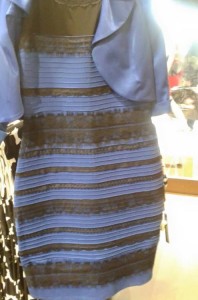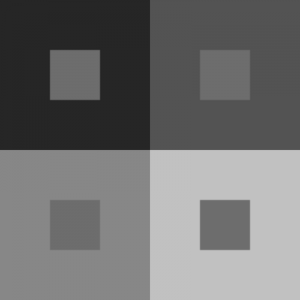Visual Illusion: Are you #TeamWhiteGold or #TeamBlueBlack?
Thursday afternoon, this photo began circulating around the internet, creating controversy and blowing minds. “The Dress” has been confirmed by the manufacturer to be Royal blue and black but the original photo is quite a polarizing optical illusion. What color do you think the dress is? Are you #TeamWhiteGold, #TeamBlueBlack or a flip-flopper? To help explain the science behind “The Dress” controversy, we asked some of our professors to weigh in.
“The Dress” has been confirmed by the manufacturer to be Royal blue and black but the original photo is quite a polarizing optical illusion. What color do you think the dress is? Are you #TeamWhiteGold, #TeamBlueBlack or a flip-flopper? To help explain the science behind “The Dress” controversy, we asked some of our professors to weigh in.
Greg Osterhaus, biology lecturer, said, "my son showed me this picture on his iPhone and I told him it was blue and black. Later, when I saw it on the news feed on my own phone I saw it as gold and bluish white. Now I can see it no other way (even though I try). This is certainly disturbing. The fact is that when two people look at the same image and have vastly different interpretations, it goes against everything we think about as truth. We experience individual differences in perception regularly.
The best example is taste. We can accept that what tastes one way to you, may taste differently to me. But eyesight is supposed to be different. If two people are functioning properly physiologically, they should both perceive black as black. But this image shows us that that isn't always true. The eyes and brain are tasked with not only bringing in wavelength information, but giving it a value that works with the environment around us.  If two people look at the same image and see it differently, then the answer must be in the anatomy/physiology, (or perhaps, less likely, the psychology).
If two people look at the same image and see it differently, then the answer must be in the anatomy/physiology, (or perhaps, less likely, the psychology).
We know that one person's blue is sometimes another person's purple or teal. But we let ourselves dismiss this as simply a naming issue. We still assume they're both seeing the same color. But the debate on this image shows us that this is not necessarily true. We also know that people can interpret the same color as being different when presented on different backgrounds as is the case with this image. The importance of the background is a description that has been given in many of the dress solutions I've read, and it has some merit, but doesn't really explain it fully. We presumably all see those "optical illusion" images the same way. The dress picture is different because people see the same picture with obvious, and strikingly different interpretations. However it probably works along the same principles. The brain is trying to make sense out of the information it has, not just reporting the wavelengths of light. "To me, this is most exciting because it brings out the wannabe scientist in all of us. Welcome to many peoples' interpretation of science," said Osterhaus.
Brian Ackley, associate professor of molecular biosciences, said.“The phenomenon of visual illusions is very powerful. The effect was achieved by the background lighting and foreground lights to put the dress at the edge of color perception. Although I haven't studied this particular case it's likely some differences in people's color perception led to the perceived differences. Like most visual illusions some people reported a "switching" effect that they could not control. That is when it switched they could not force themselves back to their original perception.”
Jennifer Delgado, lecturer in physics and astronomy, also explained that this discussion is not so much a physics phenomenon but is rather an optical illusion. “The dress looks black-blue if your eyes are using the darkest parts of the image for reference and white-gold if your eyes are using the lightest parts of the image. Changing the brightness on your screen or changing the saturation will let you see the dress differently. An overly-bright image will show gold-white, and an image with reduced brightness will show blue-black. The real colors can be found by selecting a few pixels and looking at their colors absent the surrounding image. The same kind of optical illusion can be found with these squares. The central gray squares are all the same color gray, but they look like different shades to us because of their contextual colors.”